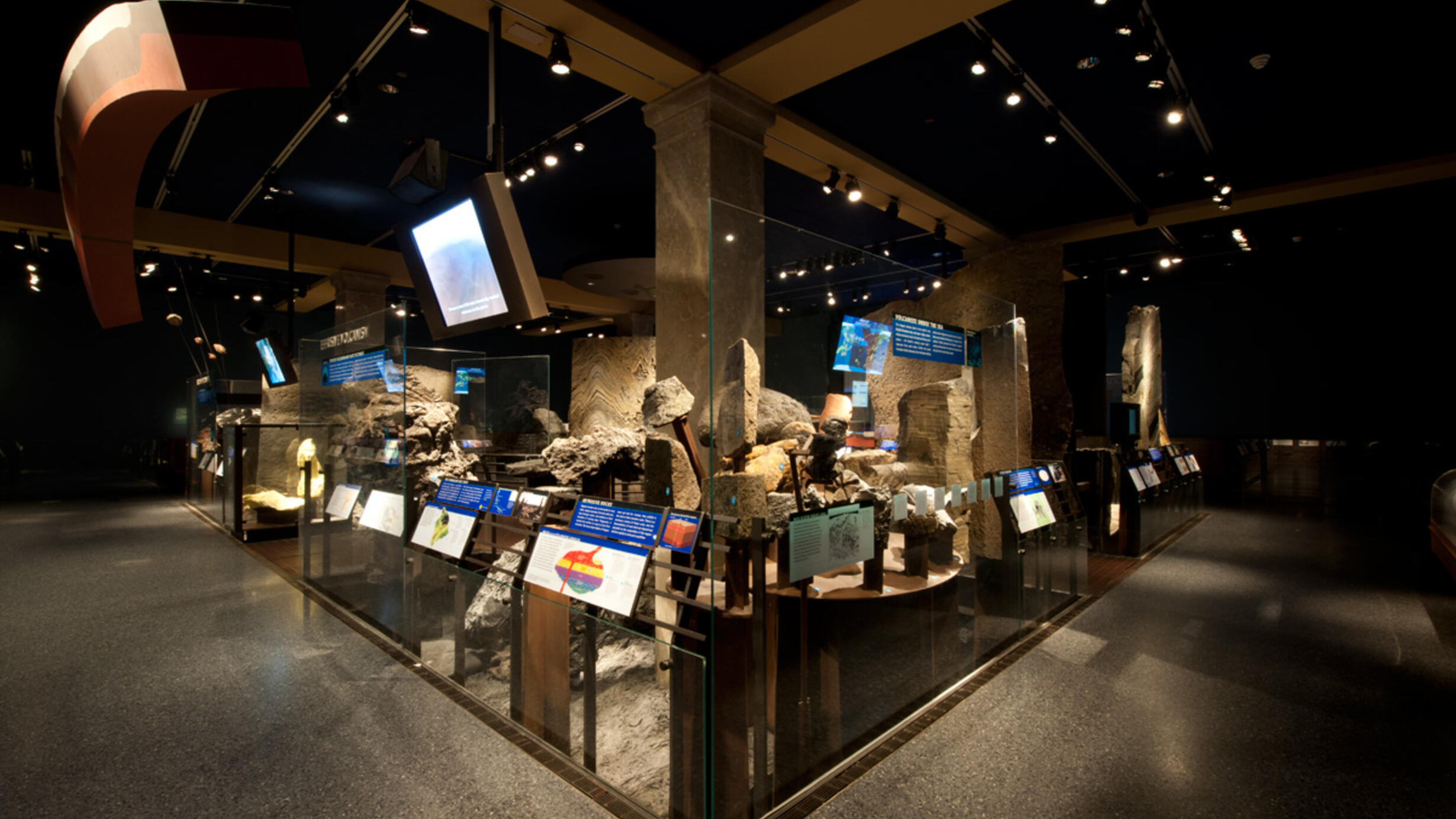Non-explosive volcanism
Part of Hall of Planet Earth.

Effusive volcanism and plate tectonics
People associate volcanoes with spectacular explosive eruptions, yet most volcanoes erupt basalt, a fluid lava from the mantle that erupts effusively and forms flows. Most basaltic lava erupts on the ocean floor, along an undersea mountain chain called the mid-ocean ridge system. Basaltic lava also erupts at “hot spots,” where molten rock, or magma, forms in plumes of hot rock that rise from deep in the Earth to penetrate a moving plate above. Over time, a chain of volcanoes forms, such as the Hawaiian Islands, aligned along the direction of the plate’s movement.
Aa (pronounced “ah-ah”) lava is more solidified and flows sluggishly compared to its more fluid counterpart, pahoehoe. Aa consists of rough, jagged, uneven pieces that tumble forward and over each other as the flow moves down the slope.
AMNH Collection
Pahoehoe (“pah-hoy-hoy”) is a form of lava produced by hot, fluid magma. The fluid nature of lava creates forms that are smooth, sinuous, and billowy.
AMNH Collection
A spatter cone is created when blobs of lava are thrown into the air from a single event. The blobs pile up on each other, forming a cone-shaped structure around the vent. Some spatter cones, such as the cast one here, form from small vents on the crust of active lava flows.
Lava may congeal around a tree to form a mold on the trunk and branches. This is common in Hawaii because certain trees there hold large amounts of water. When the hot lava comes into contact with the tree, the water turns to steam and cools the lava, solidifying it before the tree burns up.
Provided by the Kahuku Ranch, Big Island, Hawaii
This is an anorthosite, composed almost entirely of plagioclase (white). Pyroxene occupies the spaces between the plagioclase crystals. Although several thick layers of anorthosite exist in the Stillwater Complex, these rocks are rare, and how they form is poorly understood.
AMNH collection
This harzburgite is one of the lowermost layers of the Stillwater Complex. It is composed of green olivine and black orthopyroxene (bronzite). The white mineral is plagioclase (labradorite), which crystallized in the interstices after the olivine and bronzite had accumulated.
AMNH collection
This norite is composed of plagioclase (labradorite, white) and orthopyroxene (bronzite, brown). The norite layer is above the harzburgite because the plagioclase crystallized later than the olivine.
AMNH collection
This giant labradorite crystal exemplifies the texture that results when anorthosite rocks cool very slowly. The variations in color reflect small variations in chemical composition.
AMNH collection
AMNH/R.Mickens
AMNH/R.Mickens
AMNH/R.Mickens
AMNH/R.Mickens
AMNH/R.Mickens
AMNH/R.Mickens
AMNH/R.Mickens
As laval cools, the rock contracts. This causes most thick basalt flows to break into cylindrical vertical columns with a characteristic hexagonal cross section. These examples are from the Pomona flow, where columns can run up to 10 meters high and a meter across. This flow erupted from vents near what is now the Washington-Idaho border. Its lavas flowed down the Snake and Columbia River drainages all the way to the Pacific Ocean, some 600 kilometers distant. The Pomona may be the longest flow on Earth.
AMNH/R.Mickens
AMNH/R.Mickens
In This Section
Exhibit
The Hawaiian hot spot
A chain of 107 volcanoes – some islands, some submerged – extends from Hawaii to the northwest.
Exhibit
Kilauea volcano Hawaii
In 1983, lava flows from the Kilauea volcano began to encroach upon the Royal Gardens area on the island of Hawaii.
Exhibit
Intrusive rocks
Magma is molten rock.
Exhibit
Volcanoes Under the Sea
The longest volcano chain in the world is the 80,000-kilometer-long mid-ocean ridge system, where new ocean crust is formed and the...
Exhibit
Flood basalts
Among the major outpourings of lava are the huge plains known as flood basalt provinces.